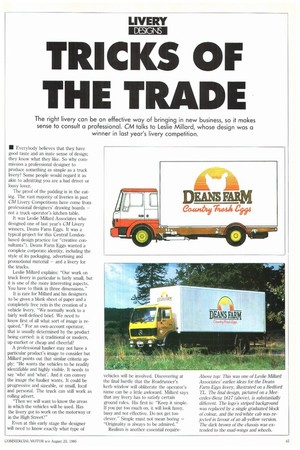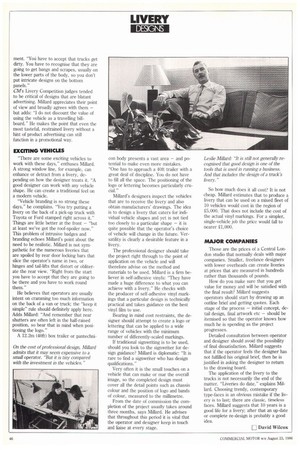TRICKS OF THE TRAD
Page 47

Page 48

If you've noticed an error in this article please click here to report it so we can fix it.
The right livery can be an effective way of bringing in new business, so it makes sense to consult a professional. CM talks to Leslie Millard, whose design was a winner in last year's livery competition.
• Everybody believes that they have good taste and an Mate sense of design: they know what they like. So why commission a professional designer to produce something as simple as a truck livery? Some people would regard it as akin to admitting you are a bad driver or lousy lover.
The proof of the pudding is in the eating. The vast majority of liveries in past CM Livery Competitions have come from professional designers' drawing boards — not a truck operator's kitchen table.
It was Leslie Millard Associates who designed one of last year's CM Livery winners, Deans Farm Eggs. It was a typical project for this Central Londonbased design practice (or "creative consultants"). Deans Farm Eggs wanted a complete corporate identity, including the style of its packaging, advertising and promotional material — and a livery for the trucks.
Leslie Millard explains: "Our work on truck livery in particular is fairly small, but it is one of the more interesting aspects. You have to think in three dimensions."
It is rare for Millard and his designers to be given a blank sheet of paper and a completely free rein in the creation of a vehicle livery. "We normally work to a fairly well-defined brief. We need to know first of all what sort of image is required." For an own-account operator, that is usually determined by the product being carried: is it traditional or modern, up-market or cheap and cheerful?
A professional haulier may not have a particular product's image to consider but Millard points out that similar criteria apply: "He wants the vehicles to be readily identifiable and highly visible. It needs to say 'who' and 'what'. And it can convey the image the haulier wants. It could be progressive and sizeable, or small, local and personal. The truck can still work as rolling advert_ "Then we will want to know the areas in which the vehicles will be used. Has the livery got to work on the motorway or in the High Street?"
Even at this early stage the designer will need to know exactly what type of 'vehicles will be involved. Discovering at the final hurdle that the Roadrunner's kerb window will obliterate the operator's name can be a little awkward. Millard says that any livery has to satisfy certain ground rules. His first is: "Keep it simple. If you put too much on, it will look fussy, busy and not effective. Do not get too clever." Simple must not mean boring — "Originality is always to be admired."
Realism is another essential require
ment. "Yon have to accept that trucks get dirty. You have to recognise that they are going to get bangs and scrapes, usually on the lower parts of the body, so you don't put intricate designs on the bottom panels."
CM's Livery Competition judges tended to be critical of designs that are blatant advertising. Millard appreciates their point of view and broadly agrees with them — but adds: "1 do not discount the value of using the vehicle as a travelling billboard." He makes the point that even the most tasteful, restrained livery without a hint of product advertising can still function in a promotional way.
EXCITING VEHICLES "There are some exciting vehicles to work with these days," enthuses Millard. A strong window line, for example, can enhance or detract from a livery, depending on how the designer treats it. "A good designer can work with any vehicle shape. He can create a traditional feel on a modern vehicle.
"Vehicle branding is so strong these days," he complains. "You try putting a livery on the back of a pick-up truck with Toyota or Ford stamped right across it." Things are little better at the front — "but at least we've got the roof-spoiler now." This problem of intrusive badges and branding echoes Millard's point about the need to be realistic. Millard is not sympathetic for the numerous liveries that are spoiled by rear door locking bars that slice the operator's name in two, or hinges and tail-lifts that distort or obliterate the rear view. "Right from the start you have to accept that they are going to be there and you have to work round them."
He believes that operators are usually intent on cramming too much information on the back of a van or truck; the "keep it simple" rule should definitely apply here. Adds Millard: "And remember that rear shutters are often left in the half-raised position, so bear that in mind when positioning the logo."
A 12.2m (40ft) box trailer or pantechni con body presents a vast area — and potential to make even more mistakes. "One has to approach a 40ft trailer with a great deal of discipline. You do not have to fill all the space. The positioning of the logo or lettering becomes particularly crucial."
Millard's designers inspect the vehicles that are to receive the livery and also obtain manufacturers' drawings. The idea is to design a livery that caters for individual vehicle shapes and yet is not tied too closely to a particular shape — it is quite possible that the operator's choice of vehicle will change in the future. Versatility is clearly a desirable feature in a livery.
The professional designer should take the project right through to the point of application on the vehicle and will therefore advise on the method and materials to be used. Millard is a firm believer in self-adhesive vinyls: "They have made a huge difference to what you can achieve with a livery." He checks with the producer of self-adhesive vinyl markings that a particular design is technically practical and takes guidance on the best vinyl film to use.
Bearing in mind cost restraints, the designer should attempt to create a logo or lettering that can be applied to a wide range of vehicles with the minimum number of differently-scaled markings.
If traditional signwriting is to be used, should you look to the signwriter for design guidance? Millard is diplomatic: "It is rare to find a signwriter who has design qualifications."
Very often it is the small touches on a vehicle that can make or mar the overall image, so the completed design must cover all the detail points such as chassis colour and the position of logo and bands of colour, measured to the millimetre.
From the date of commission the completion of the project usually takes around three months, says Millard. He advises that throughout this period it is vital that the operator and designer keep in touch and liaise at every stage.
SO how much does it all cost? It is not cheap. Millard estimates that to produce a livery that can be used on a mixed fleet of 10 vehicles would cost in the region of £5,000. That does not include the cost of the actual vinyl markings. For a simpler, single-vehicle job the price would fall to nearer £1,000.
MAJOR COMPANIES Those are the prices ol a Central London studio that normally deals with major companies. Smaller, freelance designers with lower overheads can create liveries at prices that are measured in hundreds rather than thousands of pounds.
How do you make sure that you get value for money and will be satisfied with the final result? Millard suggests operators should start by drawing up an outline brief and getting quotes. Each stage of the process — initial concept, detail design, final artwork etc — should be itemised so that the operator knows how much he is spending as the project progresses.
Detailed consultation between operator and designer should avoid the possibility of final dissatisfaction. Millard suggests that if the operator feels the designer has not fulfilled his original brief, then he is justified in asking the designer to return to the drawing board.
The application of the livery to the trucks is not necessarily the end of the matter. "Liveries do date," explains Millard. Choosing trendy, contemporary type-faces is an obvious mistake if the livery is to last; there are classic, timeless faces. Millard suggests that 10 years is a good life for a Livery; after that an up-date or complete re-design is probably a good idea.
David Wilcox












































































